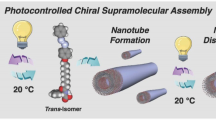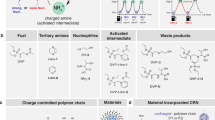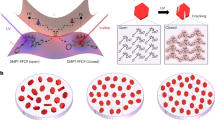Abstract
Nature has engineered exquisitely responsive systems where molecular-scale information is transferred across an interface and propagated over long length scales. Such systems rely on multiple interacting, signalling and adaptable molecular and supramolecular networks that are built on dynamic, non-equilibrium structures. Comparable synthetic systems are still in their infancy. Here, we demonstrate that the light-induced actuation of a molecularly thin interfacial layer, assembled from a hydrophilic-azobenzene-hydrophobic diblock copolymer, can result in a reversible, long-lived perturbation of a robust glassy membrane across a range of over 500 chemical bonds. We show that the out-of-equilibrium actuation is caused by the photochemical trans–cis isomerization of the azo group, a single chemical functionality, in the middle of the interfacial layer. The principles proposed here are implemented in water-dispersed nanocapsules, and have implications for on-demand release of embedded cargo molecules.
This is a preview of subscription content, access via your institution
Access options
Access Nature and 54 other Nature Portfolio journals
Get Nature+, our best-value online-access subscription
$29.99 / 30 days
cancel any time
Subscribe to this journal
Receive 12 print issues and online access
$259.00 per year
only $21.58 per issue
Buy this article
- Purchase on Springer Link
- Instant access to full article PDF
Prices may be subject to local taxes which are calculated during checkout




Similar content being viewed by others
Change history
28 June 2018
In the version of this Article originally published, multiple changes to the “Results and discussion” section were required. In paragraph 1, “(Supplementary Fig. 1)” should have read “(Fig. 1e–j and Supplementary Fig. 1)”; in the first sentence of paragraph 3, “(R6G)” should have read “(R6G, Fig. 2i)”; in paragraph 6 in the sentence beginning “Temporal release of hydrophilic...”, Supplementary Fig. 4 should have been cited after “360 nm”; in paragraph 9, in the sentence beginning “To test this...”, “Fig. 4e” should have read “Fig. 4a”; in paragraph 10, in the sentence beginning “When the irradiation...”, “(Fig. 4a–d)” should have read “(Fig. 4d,e)”; in paragraph 11, in the sentence beginning “Pristine PLA”, “P1” should have read “P2”; and in the penultimate paragraph, in the sentence beginning “Moreover, a control PEG-PLA...”, “block copolymer” should have been followed by (P5); Fig. 4g should have been Fig. 4c; “hydrophobic azobenzene small molecules” should have been followed by (12); and Fig. 4f should have been Fig. 4b. Finally, Supplementary Videos 1 and 2 were missing from the Article. All of these corrections have been made to the online versions.
References
Natansohn, A. & Rochon, P. Photoinduced motions in azobenzene-based amorphous polymers: possible photonic devices. Adv. Mater. 11, 1387–1391 (1999).
Yamada, M. et al. Photomobile polymer materials: towards light-driven plastic motors. Angew. Chem. Int. Ed. 47, 4986–4988 (2008).
Swallen, S. F. et al. Organic glasses with exceptional thermodynamic and kinetic stability. Science 315, 353–356 (2007).
Singh, S., Ediger, M. D. & de Pablo, J. J. Ultrastable glasses from in silico vapour deposition. Nat. Mater. 12, 139–144 (2013).
Dalal, S. S., Walters, D. M., Lyubimov, I., de Pablo, J. J. & Ediger, M. D. Tunable molecular orientation and elevated thermal stability of vapor-deposited organic semiconductors. Proc. Natl Acad. Sci. USA 112, 4227–4232 2015).
Bin, Y., Xia, T., Patrick, A. & Yue, Z. Light responsive block co-polymer vesicles based on a photo softening effect. Soft Matter 7, 10001–10009 (2011).
Gelebart, A. H. et al. Making waves in a photoactive polymer film. Nature 546, 632–636 (2017).
Dong, R., Zhu, B., Zhou, Y., Yana, D. & Zhu, X. Reversible photoisomerization of azobenzene containing polymeric systems driven by visible light. Polym. Chem. 4, 912–915 2013).
Wang, G., Tong, X. & Zhao, Y. Preparation of azobenzene-containing amphiphilic diblock copolymers for light-responsive micellar aggregates. Macromolecules 37, 8911–8917 (2004).
Liu, X. & Jiang, M. Optical switching of self-assembly: micellization and micelle–hollow-sphere transition of hydrogen-bonded polymers. Angew. Chem. Int. Ed. 45, 3846–3850 (2006).
Feng, Z., Lin, L., Yan, Z. & Yu, Y. Dual responsive block copolymer micelles functionalized by NIPAM and azobenzene. Macromol. Rapid Commun. 31, 640–644 (2010).
Kuiper, J. M. & Engberts, B. F. N. H-aggregation of azobenzene substituted amphiphiles in vesicular membranes. Langmuir 20, 1152–1160 (2004).
Pencer, J. & Hallett, F. R. Effects of vesicle size and shape on static and dynamic light scattering measurements. Langmuir 19, 7488–7497 (2003).
O’Reilly, R. K., Hawker, C. J. & Wooley, K. L. Cross-linked block copolymer micelles: functional nanostructures of great potential and versatility. Chem. Soc. Rev. 35, 1068–1083 (2006).
Lee, S. M., Chen, H., Dettmer, C. M., O’Halloran, T. V. & Nguyen, S. T. Polymer-caged lipsome: pH-responsive delivery system with high stability. J. Am. Chem. Soc. 129, 15096–15097 (2007).
Savariar, E. N., Aathimanikandan, S. V. & Thayumanavan, S. Supramolecular assemblies from amphiphilic homopolymers: testing the scope. J. Am. Chem. Soc. 128, 16224–16230 (2006).
Beharry, A. A. & Woolley, G. A. Azobenzene photoswitches for biomolecules. Chem. Soc. Rev. 40, 4422–4437 (2011).
Merino, E. & Ribagorda, M. Control over molecular motion using the cis–trans photoisomerization of the azo group. Beilstein J. Org. Chem. 8, 1071–1090 (2012).
Gabor, G. & Fischer, E. Spectra and cis–trans isomerism in highly bipolar derivatives of azobenzene. J. Phys. Chem. 75, 581–583 (1971).
Bandara, H. M. D. & Burdette, S. C. Photoisomerization in different classes of azobenzene. Chem. Soc. Rev. 41, 1809–1825 (2012).
Fialkowski, M. et al. Principles and implementations of dissipative (dynamic) self-assembly. J. Phys. Chem. B 110, 2482–2496 (2006).
Boekhoven, J. et al. Dissipative self-assembly of a molecular gelator by using a chemical fuel. Angew. Chem. Int. Ed. 49, 4825–4828 (2010).
Mattia, E. & Otto, S. Supramolecular systems chemistry. Nat. Nanotech. 10, 111–119 (2015).
Natansohn, A. & Rochon, P. Photoinduced motions in azo-containing polymers. Chem. Rev. 102, 4139–4175 (2002).
Marder, S. R. et al Large 1st hyperpolarizabilities in push–pull polyenes by tuning of the bond-length alteration and aromaticity. Science 263, 511–514 1994).
Jorgensen, W. L., Maxwell, D. S. & Tirado-Rives, J. Development and testing of the OPLS all atom force field on conformational energetics and properties of organic liquids. J. Am. Chem. Soc. 118, 11225–11236 (1996).
Kaminski, G. A., Friesner, R. A., Tirado-Rives, J. & Jorgensen, W. L. Evaluation and reparametrization of the OPLS-AA force field for proteins via comparison with accurate quantum chemical calculations on peptides. J. Phys. Chem. B 105, 6474–6487 (2001).
Dorgan, J. R., Lehermeier, H. & Mang, M. Thermal and rheological properties of commercial-grade poly(lactic acid). J. Polym. Environ. 8, 1–9 (2000).
Auras, R., Harte, B. & Selke, S. An overview of polylactides as packaging materials. Macromol. Biosci. 4, 835–864 (2004).
Younes, H. & Cohn, D. Phase separation in poly(ethyleneglycol)/poly(lactic acid) blends. Eur. Polym. J. 24, 765–773 (1988).
Zhao, H. et al. Preparation and characterization of PEG/PLA multiblock and triblock copolymer. Bull. Korean Chem. Soc. 33, 1638–1642 (2012).
Fang, G. J. Athermal photofluidization of glasses. Nat. Commun. 4, 1–9 (2013).
Qiu, Y., Antony, L. W., de Pablo, J. J. & Ediger, M. D. Photostability can be significantly modulated by molecular packing in glasses. J. Am. Chem. Soc. 138, 11282–11289 (2016).
Acknowledgements
The authors thank the US Army Research Office for funding through the MURI program (W911NF-15-1-0568).
Author information
Authors and Affiliations
Contributions
S.T. conceived and supervised the project. M.R.M. initiated the project. M.R.M. and P.R. performed all the experiments, with help from S.S. J.d.P. initiated the simulations and computational studies. L.A. performed all the simulation studies. All authors contributed to the discussion of the results and preparation of the manuscript.
Corresponding author
Additional information
Publisher’s note: Springer Nature remains neutral with regard to jurisdictional claims in published maps and institutional affiliations.
Supplementary information
Supplementary information
Supplementary synthesis and characterization details and analysis, Schemes 1–3, and Figures 1–16
Supplementary Movie 1
Real-time movie showing that no reaction occurred between hexamathylene diamine encapsulated within the aqueous lumen of the supramolecular capsule formed by P2 and sebacoyl chloride dissolved in hexane.
Supplementary Movie 2
Real-time movie of nylon formation between hexamathylene released from the supramolecular capsule formed by P2 upon light irradiation and sebacoyl chloride dissolved in hexane.
Rights and permissions
About this article
Cite this article
Molla, M.R., Rangadurai, P., Antony, L. et al. Dynamic actuation of glassy polymersomes through isomerization of a single azobenzene unit at the block copolymer interface. Nature Chem 10, 659–666 (2018). https://doi.org/10.1038/s41557-018-0027-6
Received:
Accepted:
Published:
Issue Date:
DOI: https://doi.org/10.1038/s41557-018-0027-6
This article is cited by
-
Photoswitchable gating of non-equilibrium enzymatic feedback in chemically communicating polymersome nanoreactors
Nature Chemistry (2023)
-
Photoinduced plasticizing effect of the addition of azobenzene on the glass transition temperature and mechanical properties of polycarbonate
Polymer Journal (2022)
-
Effect of iron-iron oxide particles on the rate of isomerization of azobenzene moieties in polymeric liquid crystals at air-water interface
Colloid and Polymer Science (2021)
-
Regulating vesicle bilayer permeability and selectivity via stimuli-triggered polymersome-to-PICsome transition
Nature Communications (2020)
-
Photosensitive nanocarriers for specific delivery of cargo into cells
Scientific Reports (2020)



